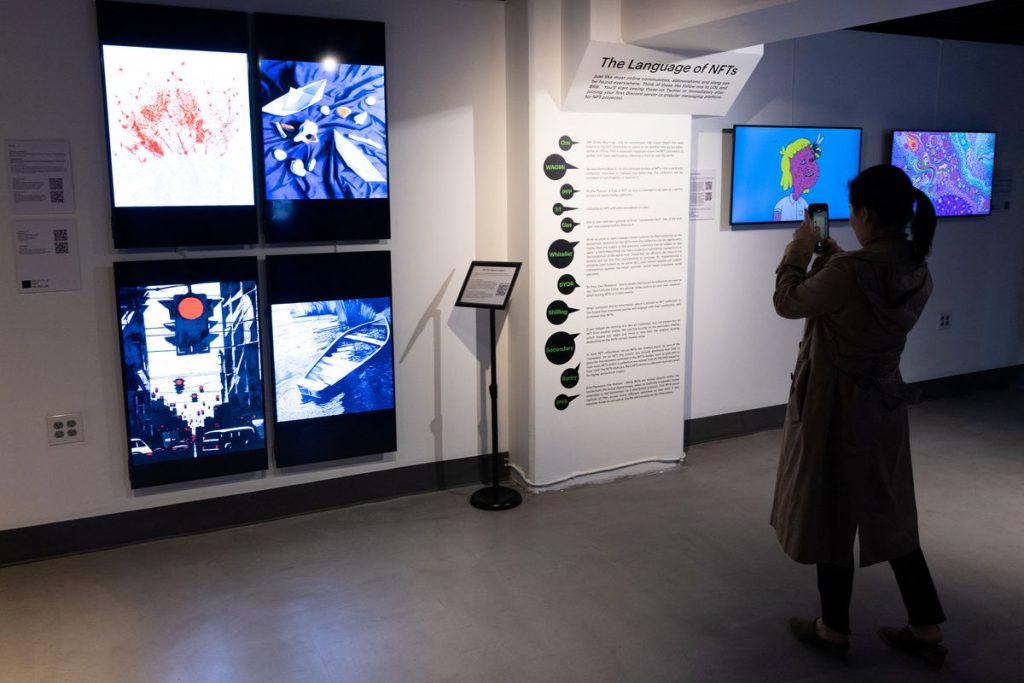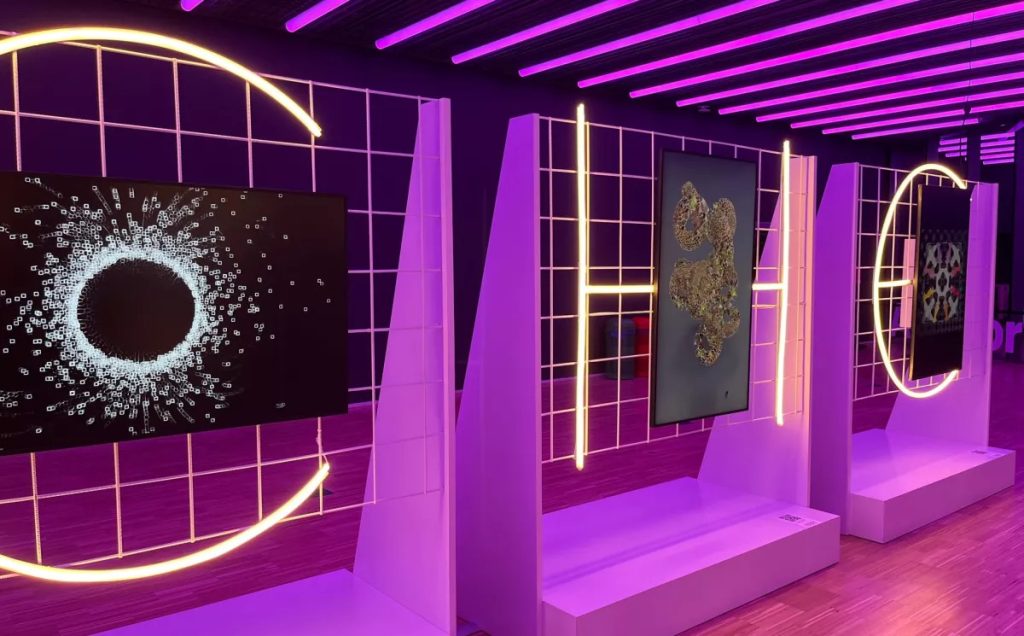Questioning the Curatorship Between the Physical and the Digital

by
by Gizem Gedik
Published October 13, 2022In this day and age, where online and offline spaces are intertwined and our behaviours and aesthetic perceptions are shaped by the data floating across our faces through millions of screens, our learned knowledge and definitions in the artistic discipline too, become vaguer. When the problematic relationship between art and capital caused artistic production and distribution to be monopolized by certain establishments and actors, independent forms of expression have found themselves a space within the online realm in the recent years. Moreover, to borrow from Boris Groys, “through the Internet, the avant-garde impulse that has driven art and writing since the beginning of the twentieth century finds its realization, its telos.”[1] Although computer technologies and the Internet seem to bring a great freedom and flexibility to offer a new living space of reality by intermingling everything and everyone that is digital and physical, it also creates the need for all actors in the field of art to be reshaped and their roles to be questioned. In this context, this text aims to serve as an introduction to consider the current situation both in the physical and the digital realm of the curator figure, which is being constantly questioned as the conditions and mediums change.
Naturally, it’s quite hard for the curators to survive in today’s image-oriented world since they do not individually produce any concrete, visual data and can only share their ideas and opinions through the production of others and in textual or verbal forms. Some curators feel responsible for preserving, gathering, and properly presenting the works that cater to their interests and world views, whether digital or physical.
It has been over 50 years since Harald Szeemann, one of the pioneers of the concept of “curator” in relation to its current meaning, generated a big wave in the artistic world with his exhibition “Live in Your Head: When Attitudes Become Form” at Kunsthalle Bern. The reason we still remember exhibitions and curators like these is because they initiated the process that challenges the relationship between artists and establishments, brought to light many works that were otherwise regarded outside the art scene, and paved the way for the open and nourishing dialogue between the curator and the artist. For decades, people have been discussing what art is and isn’t, where it can be displayed and where not, and the concepts with which it’s associated. Placed at the centre of similar questions is the curator which, etymologically means the role of “preservation, safeguarding” and since then, many tasks have been added to its traditional duties – the intellectual company of the artist, the balance between artists and establishments, cultural researcher, story-teller, entrepreneur, and many more.

Photo Credit: REUTERS/Matt Mills McKnight.
Particularly in the 1990s, when the intellectual world (philosophy, sociology, literature etc.) was well integrated into the field of art, the curators incorporated their creative thoughts into the making of the exhibitions, adopting a “nomadic” and “multicentral” lifestyle – as if paving the way to the current ideal of “decentralization” – jumping from one city to another, from one country to another, but meanwhile transforming the central and peripheral relationships into strategic moves in this process. The then-ideal mobilization of curators in a way that pushed geographical boundaries has been replaced by the digital nomad curators who utilize the blessings of technology and have been striving to make use of their intellectual accumulation in the world of data with which they’ve been trying to keep up. As they switch between platforms, from one digital exhibition to another platform or an NFT collection, sitting in front of their computers, they also witness the discussion of their redundancy with the emergence of these platforms. Today, those who claim that artists can easily use and manage their platforms by themselves, and that mediators such as curators and galleries can be removed, put forth new questions on the existence and position of curators.
What I mean by NFTs is not a new mode of producing works but only the technology for the encrypted preservation of that work. This, by its nature, excludes NFT from being a subject or medium that can be studied through curation and causes us to consider it as an extension of the digital platforms in general.
Naturally, it’s quite hard for the curators to survive in today’s image-oriented world since they do not individually produce any concrete, visual data and can only share their ideas and opinions through the production of others and in textual or verbal forms. Some curators feel responsible for preserving, gathering, and properly presenting the works that cater to their interests and world views, whether digital or physical. However, a substantial number of curators, just like the countless artists that the digital world has pushed onto the stage, are waiting to rise in the world of crypto art and NFT by turning to the speed of the day, the shine of the experience economy and the manipulability of visual perception. Reflecting on the title of Szeemann’s exhibition in the late ‘60s, “When Attitudes Become Form,” brings along new expansions: Today, attitudes and behaviours do not become form; they have to keep up with certain behaviours and attitudes determined by forms and “things,” i.e. “non-human” communities managed by humans.
New media art, computer-based production, etc., that have been encountered on the path that has recently led to digital assets called NFTs, are naturally not a recent topic. Since the 1960s, many artists have produced numerous examples from kinetic works to code-generated images, works based on the hacker culture to web-developed collective works, augmented reality to artificial intelligence, and many mind-broadening exhibitions have been held. Additionally, it was inevitable for us to reach this point, considering how our form of communication has, for a long time proceeded in the digital world as we’ve gotten used to examining works from PDFs and links and to building spaces via screens. The screen aesthetics, bright lights, capsule knowledge, and the fast-paced flow of images naturally had to adopt a new shape with the ascent of the crypto-currency market through more advanced technologies. NFTs have turned into a tool that can be accompanied by certain economic aids partly because it attracted a wealthy group of people whose interests are not limited to art and it can directly embed within itself the disciplines of graphics, designs, and architecture. However, it’s crucial to make a distinction here: What I mean by NFTs is not a new mode of producing works but only the technology for the encrypted preservation of that work. This, by its nature, excludes NFT from being a subject or medium that can be studied through curation and causes us to consider it as an extension of the digital platforms in general. The process evaluated here is about the leap that exhibitions and sales platforms have made through the rising world of NFT and how new technologies affect curatorial approaches.
We should keep in mind that the perception and taste of art consumers are shaped and transformed by game-maker establishments, story-teller curators, and online pages and spaces where they “decide” to visit based on these criteria.
When the NFT market made a fast entry into all creative fields and has been seen in the artistic discipline, the main topics of discussion revolved around the preservation of copyrights and the astronomical prices at which certain works were sold. Additionally, blooming platforms, along with the fact that motion graphics practitioners were becoming associated more and more with artists, have pressured artists and curators who have been creating with traditional methods into feeling the necessity to “be a part of this new space.” While many people, regardless of their interest in the discipline, continued their fast-paced research, it was no surprise to witness a more extensive transformation regarding the curatorial infrastructure that had already been altering in recent years. However, besides the works that make a great contribution to this bright, entertaining and attractive visual field that creates a superficial effect attracting the masses, also established artists who produce conceptually satisfying works have gradually started to find their place in the NFT world thanks to the secure encryption and certification system. In this context, a new field has emerged for curators to choose to work in or to stay away from.
As for the technical aspect of things, curators are now expected to familiarize themselves with the technologies and the terminology of this data-driven world, from graphic design to IT expertise, types of screens to display settings, all skills that are completely new to most of them. Just as knowledge of how in the physical production of works, different materials have different effects on canvas or various other surfaces, or of display apparatus and framing methods contribute to the acceleration and diversification of a curator’s work, gaining know-how in digital processes bear importance in order to follow the current art production. On a platform presented under the name of NFT Exhibitions – which I personally believe is a wrong definition- both artists and the audience wish to see mind-opening and inspiring ways of display that offer something more than screens and projections of different shapes and sizes. How does the curator serve in the meaning production and the storytelling, and what kind of an intellectual path does he/she open up for the audience? It might be too soon to answer these questions but with each innovation, we need to reflect on these again. We should keep in mind that the perception and taste of art consumers are shaped and transformed by game-maker establishments, story-teller curators, and online pages and spaces where they “decide” to visit based on these criteria.

Photo Credit: Future.
I believe it’s a beautiful conflict that reflects the spirit of times – that technology, computers, and the Internet; all things that were once utilized to access true information or to reflect reality, now warp and manipulate reality, remove us from our “boring” worlds filled with ordinary objects and people and throw us into a realm of colourful illusions and possibilities. While carrying the responsibility to learn about this world and to progress along with artists while understanding their modes of production, curators should also try to find unique concepts, whether through traditional methods or digital capabilities, to improve their intellectual space, and to benefit from the power and flexibility of technological advancement. If the online world and forms of communication can maintain its current structure that encourages collective production and incites decentralized dialogues, curators can find themselves a new area of performativity via digital production. Eventually, as emphasized by Groys, the world in its entirety is an arena of protest. In this arena, there will always be a risk of curators holding their authority over artists or establishments over curators. However, there is still hope, placed on the possibility of moving in line with common benefits and visions within a non-hierarchal, decentralized space.
[1] Boris Groys, In the Flow, London: Verso Books, 2016, 256.
